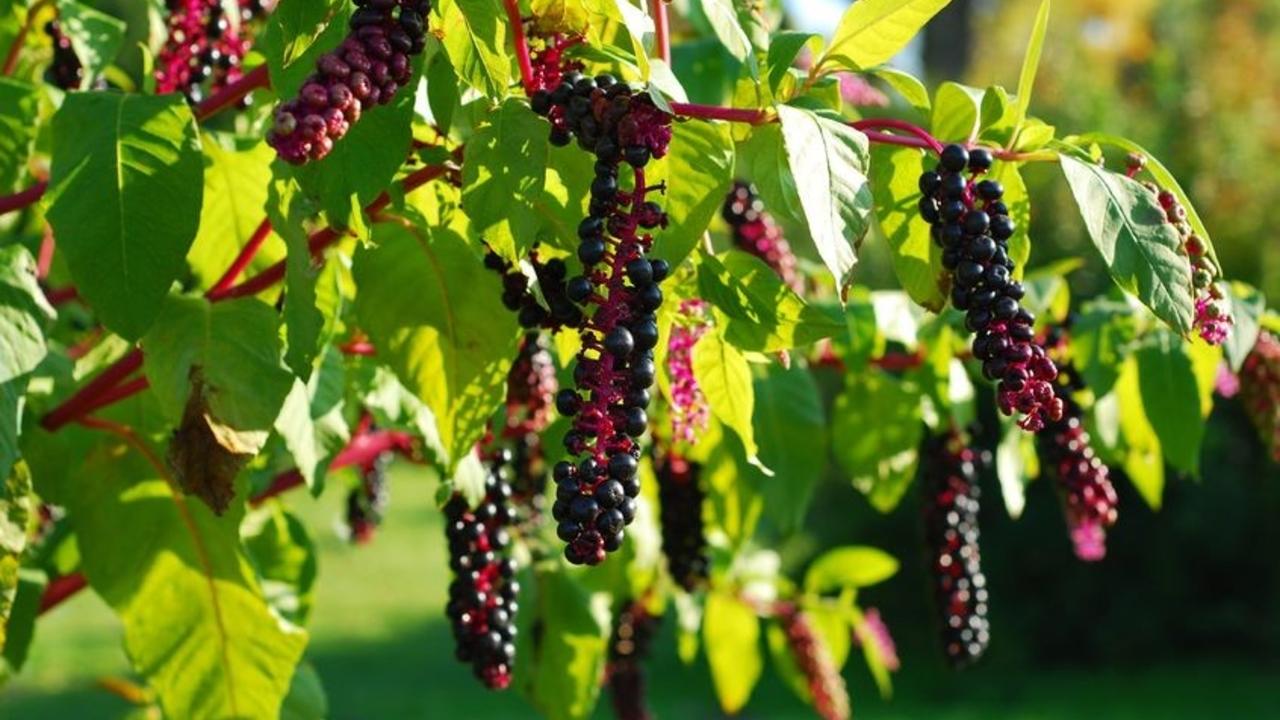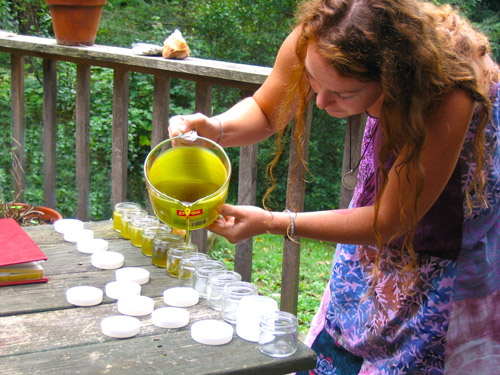Poke Root and Poke Berry Medicine

by Corinna Wood
The sight of pokeweed can strike fear into a mother's heart. Especially if your child—like mine—delights in smearing the berry juice onto their skin on Halloween (fake blood!).
Don't worry, we've found that the berry juice externally on the skin is harmless.
It is true though that internally, pokeweed can be poisonous—as well as medicinally potent.
Poke (Phytolacca americana) is a plant that spans both thfe toxic and medicinal range of properties . . . so yes, you're wise to approach the plant with caution, and armed with information.
I know when I first came to the South, I was surprised to hear a number of people report that their grandmothers always ate poke as a spring green.
Intrigued, I discovered that poke root has traditionally been used in tiny doses as an immune stimulant. And swallowing one berry a day is an old treatment for arthritis.
This powerful plant actually has a wide range of medicinal uses—but you have to treat it with respect or risk unpleasant side effects.
Table of contents
- So, how poisonous is pokeweed?
- When to harvest poke root
- Poke berry uses
- Powerful medicine with pokeweed
So, how poisonous is pokeweed?
As it turns out, there's a long history here in the mountains of using this common "weed" as a potherb. But don't make the all-too-common mistake of confusing "poke sallet" (the English word for cooked greens) with "poke salad." DON'T EAT POKE IN A SALAD!
It's considered safe ONLY when boiled in three changes of water (traditionally with some pork or "fatback"). And it should be harvested for cooking greens ONLY when the plant is less than a foot tall.
I've cooked poke this way a few times. It was certainly tasty (especially with the fatback!), but I was still a bit mystified. Why all the focus on poke?
This is a time of year when many wild greens are abundant—dandelion, chickweed and nettles are among my favorites. And with these, you don't need to toss out the cooking water (and a lot of nutrients with it). But I do know folks who say they feel a powerful energy from eating the poke greens.
My favorite to use pokeweed is to make a tincture from the root for stimulating the immune system.
Herbs can rival the effectiveness of antibiotics, and they're generally much gentler on the body. Many herbalists turn to goldenseal for this purpose, but it's an endangered species.
Poke, on the other hand, is a weed—the problem is not having too little of it, but too much. And for most purposes, poke is at least as good, if not better.
As you know, it's essential to positively identify any plants you're harvesting for food or medicine. First things first: Grab my free guide on 3 Poisonous Plants to Watch Out For (pdf) so you can stay safe on your herbal adventures.
When to harvest poke root

Poke root is best dug up in the fall after the plant has died back for the winter. This is when the plant is the most medicinal and the least toxic.
The next best time to dig the roots is in the early spring when the leaves are just coming out (as long as you're sure what you're picking!).
As anyone who's ever tried to pull up a poke plant knows, getting anything but the smallest roots out of the ground is a project.
They range in size from a large carrot to a construction cone.
Fortunately, just one small root will make enough medicine to last you and your loved ones for years—proving once again that there's no lack of good medicine all around us.
Making root tincture of pokeweed
Once you've dug up the root, the next step—if you've decided to give pokeweed a try—is drawing out those medicinal properties. I like to keep poke close in my wise woman herbal medicine chest.
The best way to do that is to make a tincture (alcohol extract):
- Wash the root, chop it into small pieces, and fill a jar with the plant material.
- Add enough 100-proof alcohol to cover the roots.
- Leave the medicine brewing on your counter for six weeks, then strain out the roots.
Voila, you have your own poke root tincture! The resulting milky liquid is remarkably mild-looking and mild-tasting, considering the punch it packs!
Poke root tincture dosage safety
Poke root tincture is so powerful that it's taken by the drop. Begin with one to three drops. Wait 24 hours. If that doesn't seem to help, add one drop per day to the dosage (and that's drops, not droppersful!).
Individuals show widely varying tolerance for poke. Some people can't handle more than three or five drops per day, while others can take 25 or 50 drops with no adverse effects.
The side effects of poke include mental unclarity, spaciness and out-of-body feelings. If you notice such feelings, it means you've found your tolerance level, so back off to a lower dosage.
If you take way too much (such as mistaking droppersful for drops, which some people have done!), you may encounter more severe side effects, such as nausea, vomiting and diarrhea.
When I was using poke for an infection years ago, I found that after taking 10 drops per day for several weeks, I started feeling unclear, spacey and disconnected, as if I weren't really in my body.
I cut the dosage back to five drops and the side effects vanished, but the tincture was still very effective. Remember, everyone's tolerance and needs are different.
Poke root tincture as an immune stimulant
Over the years, I've found poke to be invaluable as an herbal alternative to antibiotics when immune or lymphatic stimulation is needed.
For many generations, this plant has helped people with immune issues ranging from sore throat to breast cancer. And of course, there are times when antibiotics are called for—so when in doubt, consult your doctor or herbalist.
In my community, poke tincture is a favorite for sore throats, strep throat, severe colds and respiratory infections. It's also used for infected gums, swollen lymph glands and breast cysts. Studies in Germany and the United States are even finding positive results with HIV, cancer and lymphoma.
In addition, it's very effective in treating genital herpes—taking just a few drops when the tingling begins usually prevents the blister phase entirely and reduces the frequency of outbreaks.
Making poke root oil and salve
Poke root can also be made into an oil simply by substituting oil for alcohol. Any cooking oil will work, but olive oil is my favorite because of its high resistance to rancidity. And by melting in some beeswax (which gives it a creamy consistency), the oil can be made into a balm or salve.
Both the salve and the oil are also used externally to dissolve lumps, bumps, growths and tumors. And many people find them helpful when applied externally to swollen lymph glands, sore throats or breast lumps.

Making poke root oil
- Wash the root
- Chop it into small pieces (Important: wear gloves to protect skin from absorbing the medicine.)
- Leave it out to air dry in a warm place for 3-24 hours or more, until it is dry to the touch.
- Fill a jar with the chunks of the root, and add oil to cover the roots. (Note: Any oil works. Olive oil resists rancidity.)
- Leave on your counter for six weeks, topping off the oil level as needed to cover the roots.
- After six weeks, strain out the roots.
Making poke root salve
- Grate a tablespoon of beeswax for each ounce of infused oil.
- Warm the oil on low heat, add the grated beeswax, and stir until melted.
- Pour liquid into a jar and allow to cool and solidify. (Note: if consistency is too hard, remelt and add more infused oil, if too soft, remelt and add more wax.)
Poke berry uses
Poke berries are useful, too—and not just for body paint. This paint, by the way, is quite safe; it's only the seeds inside that are toxic, and then only when chewed, so pokeweed is not poisonous to touch.
Poke berries have been used—very sparingly—in various holistic healing traditions. In Appalachian folk medicine, the berries were swallowed as a treatment for arthritis and for immune stimulation—one berry (either fresh or dried) is the equivalent of one drop of root tincture.
Since the seeds are the toxic part, you just spit them out. And even if you swallow some seeds, don't worry—they're extremely difficult to break open with your teeth and will come out the other end intact. That's how poke spreads, in fact—birds love to eat the berries, and then the seeds spread through their droppings.
Although poke proliferates by seed, the plants are perennial, and the roots will grow larger every year.
Powerful medicine with pokeweed
 Pokeweed can be powerful medicine as long as you approach it with caution and use it in small dosages.
Pokeweed can be powerful medicine as long as you approach it with caution and use it in small dosages.
Make poke root into a tincture for immune support and experiment with dosing with a single drop (not a dropperful!) at a time.
Poke root oil or salve can help dissolve lumps, bumps or alleviate sore lymph nodes.
If you must try eating pokeweed greens, only do so in the early spring with leaves from short plants—under one foot tall—after boiling and pouring off the water three times.
Remember, treat pokeweed with respect, or risk unpleasant side effects. Happy digging!
Share these wise woman ways! Link to this article from your website or share with your friends using this button~
~ The commenting section is now closed ~
If you're looking for poke root medicine or have questions about using poke, reach out to Red Moon Herbs.







